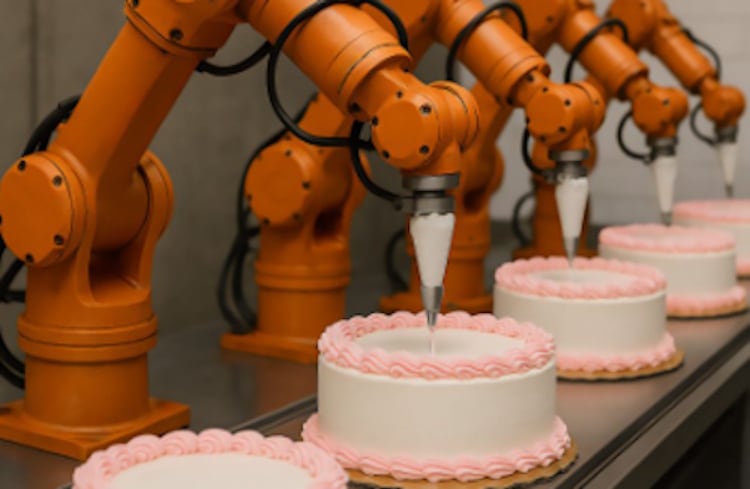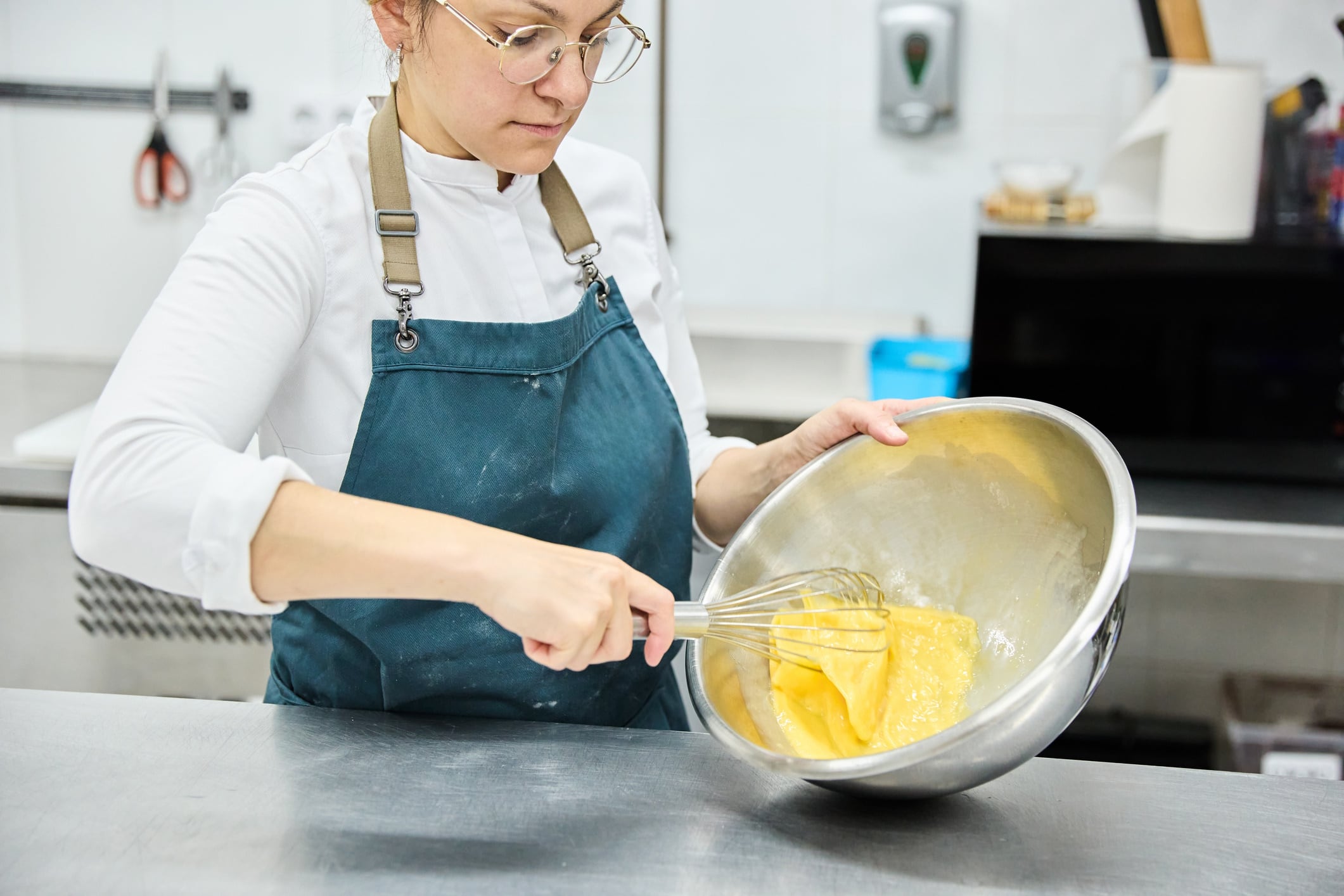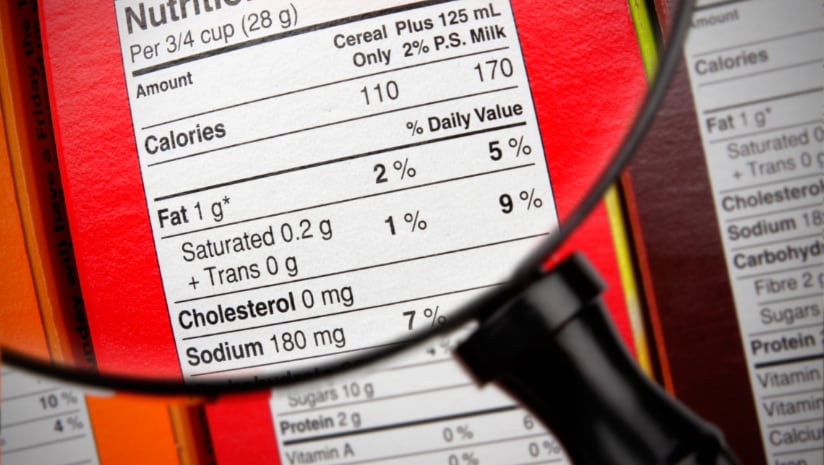Key takeaways:
- Bakery automation is uniquely challenging due to product variability and inconsistent data across legacy equipment.
- Cobots and AR tools are emerging as practical solutions, improving consistency, safety and scalability for small and mid-size bakeries.
- Upcoming ingredient reformulations and tighter regulations could reshape how and where bakeries produce, pushing the industry toward more flexible, localized manufacturing.
Walk into any bakery and you’ll smell it before you see it – the warm, chaotic hum of mixers, conveyors and humans hustling from tray to tray. But as industries from automotive to electronics embrace the robotic revolution, bakers are finding that automation isn’t as simple as swapping out hands for arms.
“A lot of it has to do with the sheer variety of different products,” Chuck Sena, food systems business unit manager at Midwest Engineered Systems (MWES), told this site at IBIE in Las Vegas. “They may be doing sweet goods and then immediately pivoting to donuts and then to cookies or muffins. You’re dealing with a lot of different dough and batter formulations, and they all behave differently.”
In other words, no two bakes are ever truly the same. That variability – the very soul of baking – makes it a nightmare for machines that thrive on precision and repetition. “Everything is going to behave a little bit differently,” Sena says. “That’s what makes the baking industry so great and so challenging at times for automation.”
It’s not that bakeries aren’t ready for change. It’s that the tools still need to catch up with the quirks of gluten, moisture and batter viscosity. And while AI, cobots and AR tools are all advancing fast, Sena says the real story is how these technologies are being adapted – carefully – to an industry where texture and timing are everything.
Is AI the magic ingredient?
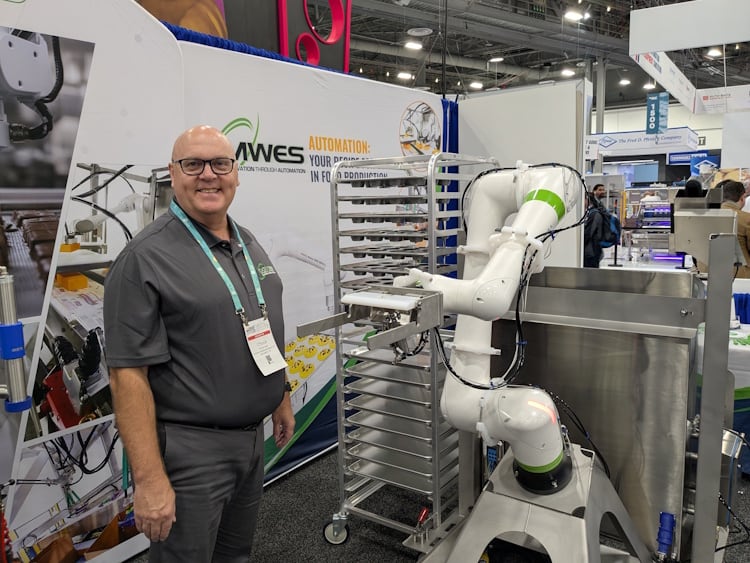
Ask a baker’s dozen of engineers what AI means for the industry and you’ll get 13 different answers. Speed? Consistency? Data? Sena thinks the real issue is that everyone’s still figuring it out.
“My personal feeling is that the industry is still trying to answer that question,” he says. “AI is only as good as the underlying data. It’s garbage in, garbage out.”
Inconsistent or incomplete data – often due to legacy machinery – limits what AI can actually do. “Equipment manufacturers may not be providing the level of data collection needed to leverage AI to its fullest. It’s got great potential, but it’s going to take time.”
What’s likely to catch on sooner, he says, is virtual and augmented reality. MWES is already working on a project that allows maintenance staff to use smart glasses for remote support and training. “It cuts costs, improves response time and provides a good knowledge transfer to the baker so they can handle it themselves,” Sensa explains.
For bakeries still struggling to recruit skilled maintenance talent, this could be a lifeline. “You can’t find people who know both automation and dough. AR can at least bridge that gap.”
Cobots: collaboration, not replacement

If AI is the brain, cobots are the hands – and they’re already reshaping production lines. Cobots – shorthand for collaborative robots – are robotic arms equipped with sensors that detect abnormal resistance or obstructions, stopping instantly to prevent harm.
“They allow people to use equipment without the heavy guarding traditional robots require,” Sena says. “In small and medium bakeries, that’s a tremendous benefit. You can use them in tight spaces and still allow access to the line.”
Cobots also deliver one thing every baker craves: consistency. “When you give someone a tool that lets them be as repeatable as possible, that’s going to result in more consistent product, less scrap, less waste,” says Sena. “And you’ll do a better job controlling ingredients, too – and those costs add up fast.”
He notes an installation that’s in progress for a pet food manufacturer where workers have to climb ladders to load trays into overhead dehydrators – a safety hazard and a product-quality nightmare. “The product rolls back on the pan and dries unevenly,” he says. “Using collaborative robots will solve the safety issue, and will also fix yield and consistency.”
As for fears that cobots will replace humans? Sena’s not convinced. “There’s always a little bit of resistance out there,” he admits. “But ideally, that person isn’t being replaced. They’re being freed up to do something more technical – and usually, that comes with a bump in salary.”
Cobots in context
The tech: Cobots (collaborative robots) are designed to work safely alongside humans, using built-in sensors to stop instantly if they detect resistance or obstruction.
The edge: Unlike traditional robots, cobots can fit into tight spaces, move between lines and handle short or mixed product runs – perfect for bakeries juggling multiple SKUs.
The payoff: Beyond labor savings, cobots boost consistency, cut waste and improve product quality and worker safety. They also make it easier for small and mid-size bakers to scale without major capital investment.
Beyond labor: scaling smarter

To Sena, the most exciting development in bakery automation isn’t about eliminating jobs but empowering smaller bakeries to scale.
“The BakerMate platform was designed as an entry point,” he explains. “There’s a huge segment of regional and local bakeries that are underserved. The big guys – your Flowers, your Crowns – they can run long lines with limited SKUs. But local manufacturers are juggling short runs and multiple product types. They need flexibility.”
The BakerMate units are modular and mobile – “on casters, like everything else in a bakery. It’s almost like a Lego set. You can recombine different operations in different orders.” That flexibility means smaller producers can grow without committing to massive capital investment.
It’s a sign of where automation is heading: not toward bigger factories, but smarter, more modular systems that evolve with the baker. “As companies grow, their automation can scale right along with them,” he says.
The reformulation ripple
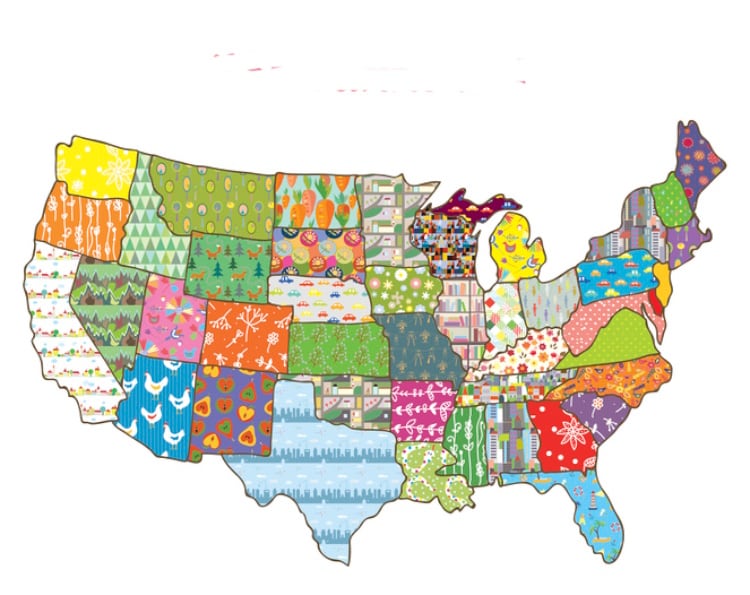
Ask Sena what keeps him up at night, and it’s not robots. It’s reformulation.
“We’re on the cusp of the great reformulation,” he warns. “Between ‘Make America Healthy Again’ initiatives and potential ingredient restrictions, the entire manufacturing paradigm could shift.”
He’s watching closely as regulators – and even individual states – tighten standards around ‘acceptable’ ingredients. “You’ve now got 30 or 35 states coming up with their own lists,” he says. “If it gets that fragmented, how do you operate one central facility that serves everyone? It’s incredibly complex.”
That could mean more localized manufacturing, shorter distribution runs and a shift away from the sprawling mega-plants that have defined North American baking for decades. “We might start to look more like Europe,” Sena suggests. “More local production, smaller distribution areas.”
And if shelf-life regulations tighten, bakeries may need to rethink everything from logistics to product design. “You can’t have something on a truck going from the West Coast to the East Coast if you’ve lost half your shelf life by the weekend. Where things are made, how they’re made, the size of production runs – all of that could be disrupted.”
In short, the reformulation debate isn’t just about ingredients. It’s about automation, packaging and supply chain survival.
The bakery of 2035
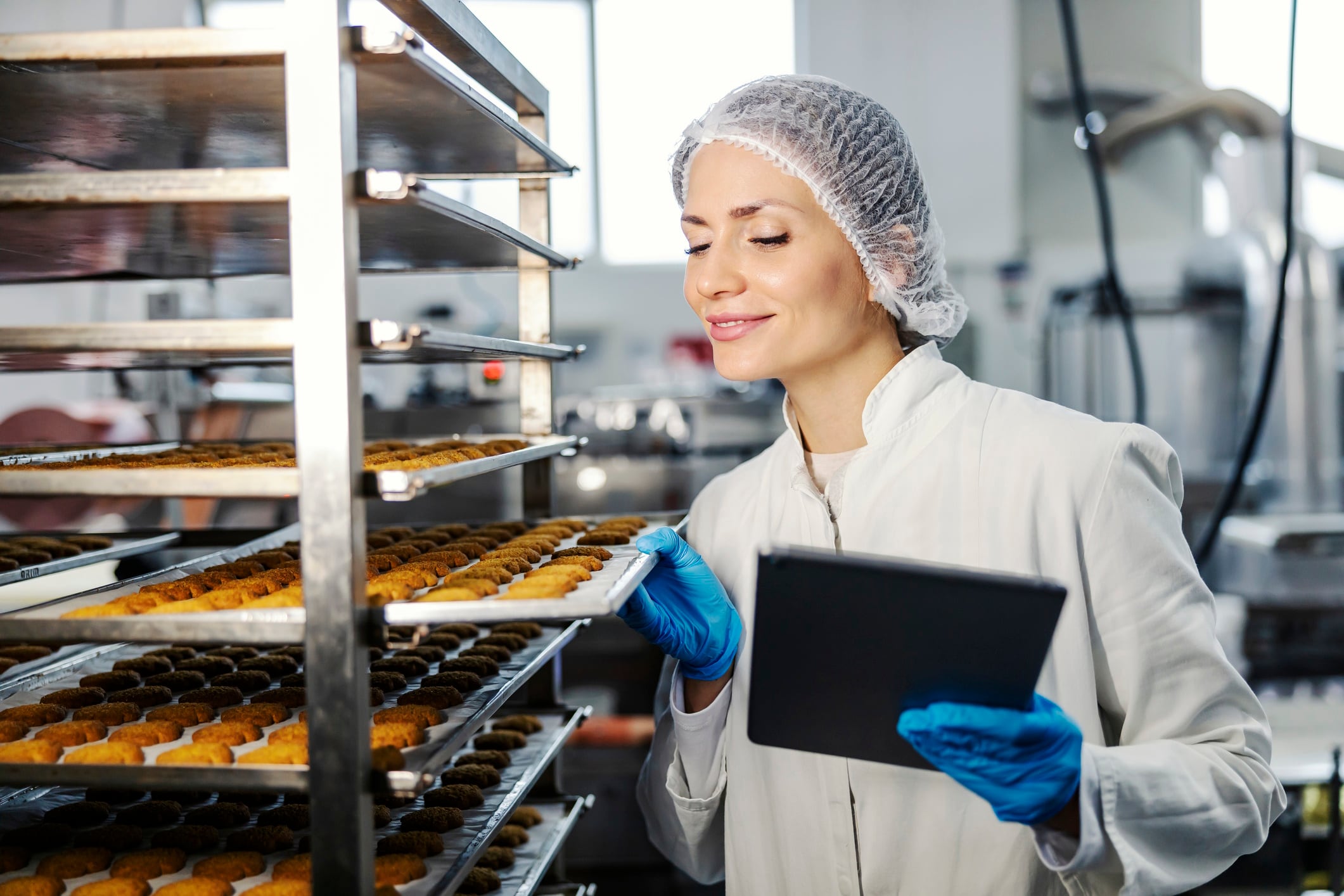
So what does the future look like? Smaller portions, smarter systems and cleaner machines, says Sena.
“We’ll see portion sizes shrink a little due to health concerns. Reformulations will continue. And with the rise of e-commerce and new packaging formats, flexibility will be everything.”
Hygienic design, long overlooked in baking, is another area catching up fast. “Just because I put it through an oven doesn’t mean it’s totally safe anymore. There are still a lot of mild steel conveyors out there with paint chips that might fall off – is that a sprinkle on my cupcake?”
MWES has been proactive in redesigning its systems for cleanability. “We’ve reduced surface area, allowed for good drainage, and limited potential harborage points,” he says. “There’s a push for more manufacturers to follow the ANSI A50 standards for hygienic design, and the Bakery Equipment Assessment Group is leading that charge.”
That focus on hygiene, flexibility and collaboration might just define the next decade of baking. As Sena puts it: “Baking is kind of the tip of the spear. You can’t apply high-pressure treatments to a cupcake like you can to pet food or vegetables. So what happens here could be a barometer for the rest of food manufacturing.
“Automation for automation’s sake doesn’t help anyone. We’re not fans of applying technology just because it’s shiny. We pick the right tools to solve real problems. If all you have is a hammer, every problem looks like a nail – and we don’t work that way.”
For bakers looking to futureproof their lines, that might be the smartest recipe of all.


